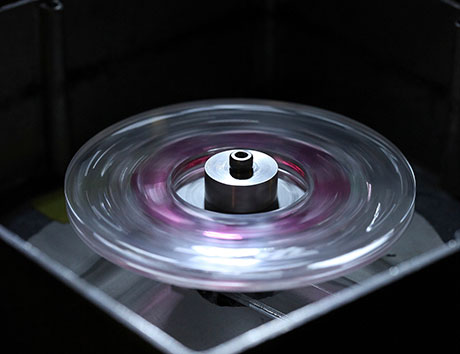Overall goal:
To investigate new nanomechanical sensor systems for fundamental studies of the behavior of molecules and cells and structural properties of molecules and materials
In IDUN Sensor we are designing, fabricating, testing and integrating various new sensors (e.g. electrodes, micro-resonators, substrates for Raman scattering, cantilevers). Different types of sensors are developed, studied and applied for analysis and their performance is compared with conventional analysis methods. One of our main goals is the integration of suitable sensors in a centrifugal microfluidic system. In this system sample pre-treatment such as filtration and up-concentration, extraction as well as detection can be done on a single fluidic platform without the need for external liquid handling module (e.g. pumps). The aim is to integrate all sample-handling steps as well as sensing on the centrifugal, lab on disc device. Recently we have made major progress in the adaptation of several sample pre-treatment steps as well as integration of sensors on an in-house custom designed and fabricated centrifugal platform.

Photo of a spinning disc used for centrifugal microfluidics
Various sensing strategies are investigated such as surface enhanced Raman scattering (SERS), used for qualitative as well as quantitative determination of analytes based on their molecular fingerprint. In the Center we have people who are truly experts in Raman spectroscopy and who have developed a specific SERS substrate for extremely sensitive detection. At IDUN Sensor the substrate is used to detect small amounts of specific molecules of interest present in complex matrices such as urine or blood samples or the supernatant of bacteria cultures.
We are also developing sensors and detection strategies for quantification of electrochemically active compounds (e.g. pharmaceuticals, metabolites). When aiming for integration with microfluidics, electrochemical detection has certain advantage, such as possibility for multiplexing, automation, miniaturization of the sensor (electrode) and instrumentation without losing the performance.
In parallel we are developing a centrifugal fluidic platform for cell culturing where the aim is to integrate sensors (electrodes) to monitor cell growth and electrodes and/or SERS chips for the detection of pharmaceuticals through the cell layer.
We are using IR absorption spectroscopy in combination with so called microelectromechanical systems (MEMS) (e.g. nano- or micro-strings or membranes) for evaluation of properties of pharmaceutical. We have accomplished to detect the change in crystallinity over time of a sample of a few femtograms of drug and based on MEMS devices we have successfully measured very precisely the buoyant mass of a yeast cell using a hollow string as a resonator.
Other sensor systems are also being investigated, such as functionalized microbeads used in agglutination assay combined with optical detection using a Unisensor system, cantilevers and micro-bridges for monitoring of polymer degradation. Furthermore, we are looking into new materials for fabricating sensors as well as how we can handle and process the large amount of data we are generating.